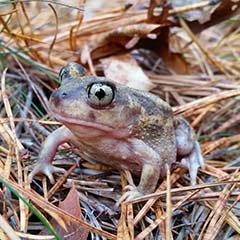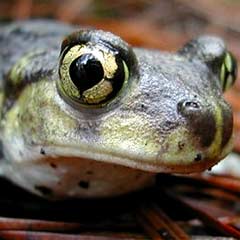
Eastern spadefoot toad
Eastern Spadefoot Toad Conservation
Since 2009, we've worked with Mass Audubon to restore these toads to their former range by designing and building vernal pools and headstarting toads for reintroduction to the wild.
Building new Breeding Pools for Eastern Spadefoot Toads

Vernal pool at Ashumet Holly Wildlife Sanctuary
Since 2009, we've partnered with Mass Audubon’s Long Pasture Wildlife Sanctuary to help restore the eastern spadefoot toad to areas of its former range. One site where spadefoots had been observed into the 1990’s, but not since, was Mass Audubon’s Ashumet Holly Wildlife Sanctuary in Falmouth, Massachusetts. Under the leadership of sanctuary director Ian Ives, and with the help of noted wetland restoration expert Thomas Biebighauser, we've assisted in the design and creation of 13 new, small vernal pools at Ashumet Holly and Long Pasture Wildlife Sanctuaries.
Since 2013, we've helped to headstart eastern spadefoot toads, taken as eggs from a large population in Barnstable, Massachusetts, and then released several thousand in suitable habitat near the newly created pools at Ashumet Holly Wildlife Sanctuary. To date, we've helped reintroduce more than 8,000 juvenile eastern spadefoot toads to Ashumet Holly Wildlife Sanctuary.

 The eastern spadefoot toad (
The eastern spadefoot toad ( Likely, a primary cause of the decline of eastern spadefoot toads throughout their range has been the filling and draining of the small, ephemeral vernal pools that spadefoot toads depend upon as breeding habitat. Since they inhabit dry, sandy portions of the coastal plain in the northeastern United States, much of their habitat has been destroyed through centuries of urbanization and agriculture. Pesticides and pollutants may be a threat to eggs and tadpoles, and some Massachusetts adults have tested positive for a skin fungus,
Likely, a primary cause of the decline of eastern spadefoot toads throughout their range has been the filling and draining of the small, ephemeral vernal pools that spadefoot toads depend upon as breeding habitat. Since they inhabit dry, sandy portions of the coastal plain in the northeastern United States, much of their habitat has been destroyed through centuries of urbanization and agriculture. Pesticides and pollutants may be a threat to eggs and tadpoles, and some Massachusetts adults have tested positive for a skin fungus, 